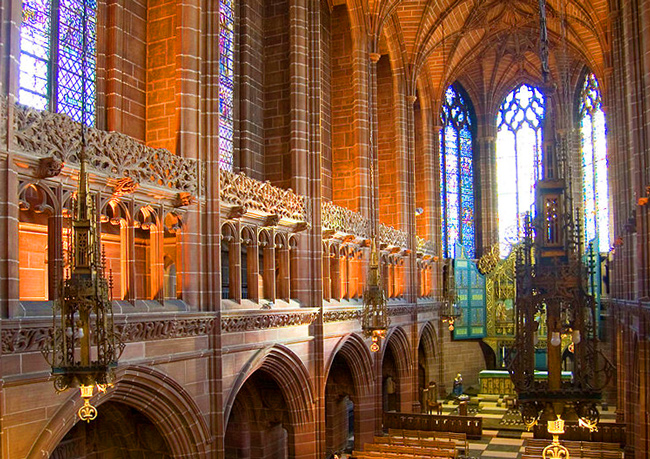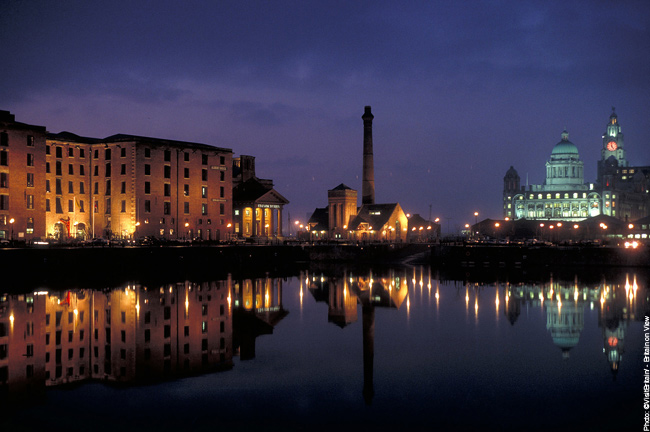Two cathedrals, three Graces and four Beatles, Liverpool has always been a key player on the world stage – and this Northwest gem continues to enchant and entertain
Liverpool is not a city that hides its light under a bushel. “We’ve got bragging rights on everything,” says Blue Badge guide Sylvia McMurtry who was born and bred in the city.
More museums and galleries than any other UK city outside of London, more Georgian buildings than Bath, two cathedrals – both built in the 20th century – a waterfront that was granted UNESCO World Heritage Site status in 2004 and birthplace of The Beatles, which contributed to Liverpool’s entry in the Guinness Book of Records for having more artists to have had number one hits than artists from any other city.
Founded as a borough in 1207 and granted city status in 1880, Liverpool grew up and became wealthy due to its seaport, which built its reputation on trade, sometimes of less honourable sorts. With easy access to trade goods like cloth, guns and iron, Liverpool merchants had soon overtaken those of London and Bristol and, by the 1780s, Liverpool was the capital of the Transatlantic Slave Trade, controlling 80 per cent of Britain’s slave commerce. At the International Slavery Museum – from where you can gaze over at what once was George’s Dock where slave ships bound for Africa loaded their goods. Two paintings – of Liverpool in 1725 and 1811 – hang side by side showing just how the town and port had grown. During this period the slave trade and the associated trade to the West Indies generated about 40 per cent of Liverpool’s wealth.
As the city got overcrowded, the wealthy merchants started to move from the centre and relocated to new parts of town such as Duke Street, Rodney Street and Hope Street. This area, with its Georgian town houses and olde-worlde charm, is a film maker’s dream and as such has appeared in everything from The Forsyte Saga to Guy Ritchie’s Sherlock Holmes. Rodney Street’s multitude of blue plaques highlight the famous faces that have lived here including William Ewart Gladstone (1809-1898) – Liverpool MP and four times Prime Minister, one term more than Thatcher – at number 62, and renowned portrait photographer, E Chambré Hardman (1898-1988), at number 59. Today, this National Trust-owned house is kept as a 1950s time capsule with artist’s studio and darkroom.
At either end of the aptly-named Hope Street lie the city’s two cathedrals: the most recognisable probably being the Roman Catholic Metropolitan Cathedral, dubbed ‘Paddy’s Wigwam’ due to its tepee shape. Designed by Sir Frederick Ernest Gibberd – the man also responsible for Heathrow’s Terminal One – the cathedral was completed in 1967 to a series of strict guidelines: it had to be completed within ten years, incorporate Lutyens’ crypt in the structure and ensure that every member of the congregation could see the altar, bringing Mass into ‘the round’. As a result, it stands in direct contrast to the traditional Gothic-style red sandstone Liverpool Cathedral.

Unlike the five years it took to build the Catholic cathedral, Liverpool Cathedral took over 70 years to complete and is the world’s largest Anglican cathedral with the highest and widest Gothic arches and the largest organ in Britain boasting 10,268 pipes. After a trip up the massive Vestey Tower (be warned there are 108 steps and, at 331ft, it’s windy) you might be lucky enough to witness the choir warming up for a recital and experience the truly impressive acoustics. Visitors puzzled by the appearance of red telephone box inside the cathedral should know that it is a homage to the building’s, rather controversially, Catholic designer, Sir Giles Gilbert Scott – just 22 years old when he won the cathedral commission – who also designed the iconic box, as well as Battersea Power Station. Tracy Emin, a name you might not automatically link to the church, also has a piece on display here. Her pink neon, wall mounted sign, For You, which states, “I felt you and I knew you loved me” seems oddly at home beneath the epic stained glass West Window which casts a rainbow spectrum over the surrounding stone. Sylvia remembers the Futuresonic festival here last year when the cathedral bells – the highest and heaviest peal of bells in the world – rang out John Lennon’s Imagine. “It was absolutely awesome to feel that building vibrate with his music,” she enthuses.
Memories of John Lennon and his fellow Beatles are everywhere in the city, from the street sculpture, Liverpool: A Case History, on Hope Street – concrete castings of pieces of luggage belonging to Liverpool celebrities, including The Beatles’ guitar cases – to the Liverpool Institute High School for Boys (where a young Paul McCartney and George Harrison had their education), reopened by Paul in 1996 as fame school LIPA (Liverpool Institute of Performing Arts).
Known as the Fab Four, Paul McCartney, John Lennon, Ringo Starr and George Harrison dominated the Merseybeat music scene of the 1960s. Sailors, dubbed ‘Cunard Yanks’, would return from New York and New Orleans bringing with them early rock and roll, skiffle and rhythm and blues, which was given an extra special twist to make it the Mersey sound. “It was the best time to be a teenager,” says Sylvia who was at the Woolton village fete in 1957 where John and Paul first met, and years later, at the height of Beatlemania, screamed for her idols as they stood on the balcony of the Town Hall. “When the Cavern started those lunchtime sessions I used to lie through my teeth to get out of school. John Lennon has a lot to answer for my exam results.”

The Cavern club on Mathew Street is still a must for music lovers, and Beatles aficionados won’t want to miss The Beatles Story at Albert Dock. It’s just one of many attractions – many free – housed within the UK’s largest collection of Grade I-listed warehouses that were refurbished in the 1980s. Here, too, is the National Maritime Museum with its fascinating exhibition on RMS Titanic. Although she set sail from Southampton in 1912, Titanic was registered in Liverpool (White Star Line had its head office in James Street) and so carried the city’s name on her stern, and a largely Liverpudlian crew, including Fred Fleet, Titantic’s lookout who spotted the iceberg. In the early hours of 15 April 1912, Titanic’s 705 survivors and their 13 lifeboats were rescued by Liverpool-based Cunard liner, RMS Carpathia. Although, tragically her own fame was short lived as she was sunk six years later by a German U-boat in the Atlantic.
Walk around the world famous dock, where colourful barges such as Brocklebank and tall ships jostle for moorings. Look up and you’ll see the top pods of the Echo Wheel of Liverpool peeping over the warehouses. A quick stop in one of the many cafes and bars here, or a sugary treat from the Charlie and the Chocolate Factory-esque Quay Confectionary, and it’s time for the Tate. Henry Tate was a Liverpudlian business man, one of the major employers of the port, and when he originally gave his collection of contemporary art to London, Liverpool was most affronted. Following the refurbishment of the docks and the opening of the gallery here in 1988 “the Tate came home”. Exhibitions are ever changing, I was lucky enough to experience the DLA Piper Series: This is Sculpture featuring a silent disco, illuminated dancefloor designed by Wayne Hemingway and disco companions in the shape of artwork by Antony Gormley and Sarah Lucas.
Culture abounds in this city, so much so that there’s even a Cultural Quarter, made up of yet more free museums and galleries, including the Walker Art Gallery and World Museum Liverpool. However, this area is dominated by the Grade I-listed St George’s Hall, widely regarded as one of the finest neo-classical buildings in the world and declared to be “worthy of ancient Athens” by Queen Victoria. The work of young London architect, Harvey Lonsdale Elmes, and opened to the public in 1854, it truly is one of a kind; a breathtaking concert hall with priceless Minton mosaic floor, surrounded by law courts at each end. Where else could you be “tried for murder, attend a ball or listen to a concert”?
Like Liverpool it is unique. Take the ferry ‘Cross the Mersey’ and you’ll find yourself looking back on the Three Graces: the Cunard Building, Port of Liverpool Building, and most famously, the Royal Liver Building. It boasts two enormous clocks, originally named George clocks because they were started at the precise time that King George V was crowned on 22 June 1911, whose faces are larger than London’s Big Ben. Atop each tower stand Carl Bernard Bartels’ mythical Liver birds, one looking out over the city to protect its people, the other bird looking out to sea, the source of its prosperity. Or perhaps, there’s more truth in local legend that states the male Liver bird is looking to see if the pubs are open, while the female looks out for sailors.
Something that can’t be disputed is this waterfront’s iconic status. As Sylvia admits, “When you sail up the Mersey and see the Liver Building you know you can be nowhere else.”
Discover our editor’s favourite places to visit in Liverpool!
Learn more about our Kings and Queens, castles and cathedrals, countryside and coastline in every issue of BRITAIN magazine!






 © 2024
© 2024